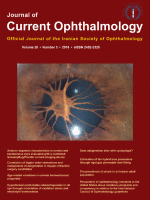The prevalence of ptosis in an Iranian adult population
Authors
Affiliations
1Noor Research Center for Ophthalmic Epidemiology, Noor Eye Hospital, Tehran, Iran.
2Department of Medical Surgical Nursing, School of Nursing and Midwifery, Shahid Beheshti University of Medical Sciences, Tehran, Iran.
3Center for Health Related Social and Behavioral Sciences Research, School of Public Health, Shahroud University of Medical Sciences, Shahroud, Iran.
4Department of Optometry, School of Paramedical Sciences, Mashhad University of Medical Sciences, Mashhad, Iran.
5Farabi Eye Hospital, School of Medicine, Tehran University of Medical Sciences, Tehran, Iran.
6Noor Ophthalmology Research Center, Noor Eye Hospital, Tehran, Iran.
7Department of Epidemiology and Biostatistics, School of Public Health, Tehran University of Medical Sciences, Tehran, Iran.
Abstract
Purpose: To determine upper eyelid ptosis prevalence and some related factors in 44- to 69-year-olds of Shahroud in the north of Iran.
Methods: In 2009, using multi-stage cluster sampling, 300 clusters of 40-64-year-olds were selected in Shahroud city, and all 5190 participants were invited to be re-examined in 5 years (2014). The current report is the second phase of the study in which 4737 (91.3%) people participated and underwent vision tests, slit lamp examination, biometry, and ophthalmoscopy in 2014. Upper eyelid ptosis was determined by an ophthalmologist.
Results: The prevalence of upper eyelid ptosis was 4.7% [95% confidence interval (CI): 4.1-5.4]; 5.2% in women and in 4.0% in men. The prevalence of bilateral and unilateral ptosis was 1.3% (95% CI: 1.0-1.7) and 3.4% (95% CI: 2.8-4.0), respectively. The observed prevalence of ptosis was 3.1% in the 45- to 49-year age group and 5.8% in 65- to 69-year-olds. The prevalence of ptosis increased with age. In the multiple logistic regression model, ptosis prevalence correlated with older age, diabetes (odds ratio = 1.53, 95% CI: 1.16-2.02) and hypertension (odds ratio = 1.41, 95% CI: 1.03-2.92). Mean corneal astigmatism was 1.02 (95%C]: 0.87-1.18) diopter in ptotic eyes and 0.87 (95% CI: 0.84-0.89) diopter in non-ptotic eyes (p = 0.013).
Conclusions: The present report provides valuable information on the prevalence of ptosis in a population of 45-to 69-year-olds. The prevalence of ptosis in this study was considerably high and significantly increased with age.
Keywords: Adult; Iran; Middle-east; Population based-study; Ptosis.

